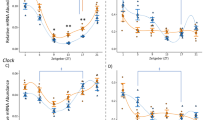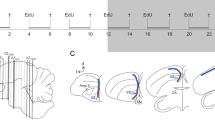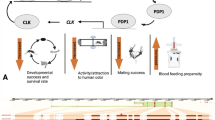Abstract
ENDOGENOUS diurnal rhythms in animals have been explicitly described1. Innateness of these rhythms is one of the most important characteristics.
This is a preview of subscription content, access via your institution
Access options
Subscribe to this journal
Receive 51 print issues and online access
$199.00 per year
only $3.90 per issue
Buy this article
- Purchase on SpringerLink
- Instant access to full article PDF
Prices may be subject to local taxes which are calculated during checkout
Similar content being viewed by others
References
Aschoff, J., Ann. Rev. Physiol., 25, 581 (1963). Buenning, E., The Physiological Clock, 145 (Academic Press, Inc., New York, 1964). Harker, J., The Physiology of Diurnal Rhythms, 114 (Cambridge Univ. Press, 1964).
Nielsen, E. T., and Haeger, J. S., Bull. Entomol. Res., 45, 757 (1954).
Provost, M. W., and Lum, P. T. M., Ann. Entomol. Soc. Amer., 60, 138 (1967).
Provost, M. W., Lum, P. T. M., and Bourinot, L. M., Ann. Entomol. Soc. Amer., 58, 937 (1965).
Pittendrigh, C. S., and Bruce, V. G., Photoperiodism and Related Phenomena in Plants and Animals, 475 (American Association for the Advancement of Science, Washington, B. C., 1959).
Bruce, V. G., Cold Spring Harb. Symp. Quant. Biol., 25, 29 (1960).
De Coursey, P., Cold Spring Harb. Symp. Quant. Biol., 25, 49 (1960).
Author information
Authors and Affiliations
Rights and permissions
About this article
Cite this article
NAYAR, J. Endogenous Diurnal Rhythm of Pupation in a Mosquito Population. Nature 214, 828–829 (1967). https://doi.org/10.1038/214828a0
Received:
Revised:
Issue date:
DOI: https://doi.org/10.1038/214828a0
This article is cited by
-
Interaction of light regimes and circadian clocks modulate timing of pre-adult developmental events in Drosophila
BMC Developmental Biology (2014)
-
Circadian control of the cellular response to ?-ecdysone in Drosophila lebanonensis
Chromosoma (1974)



